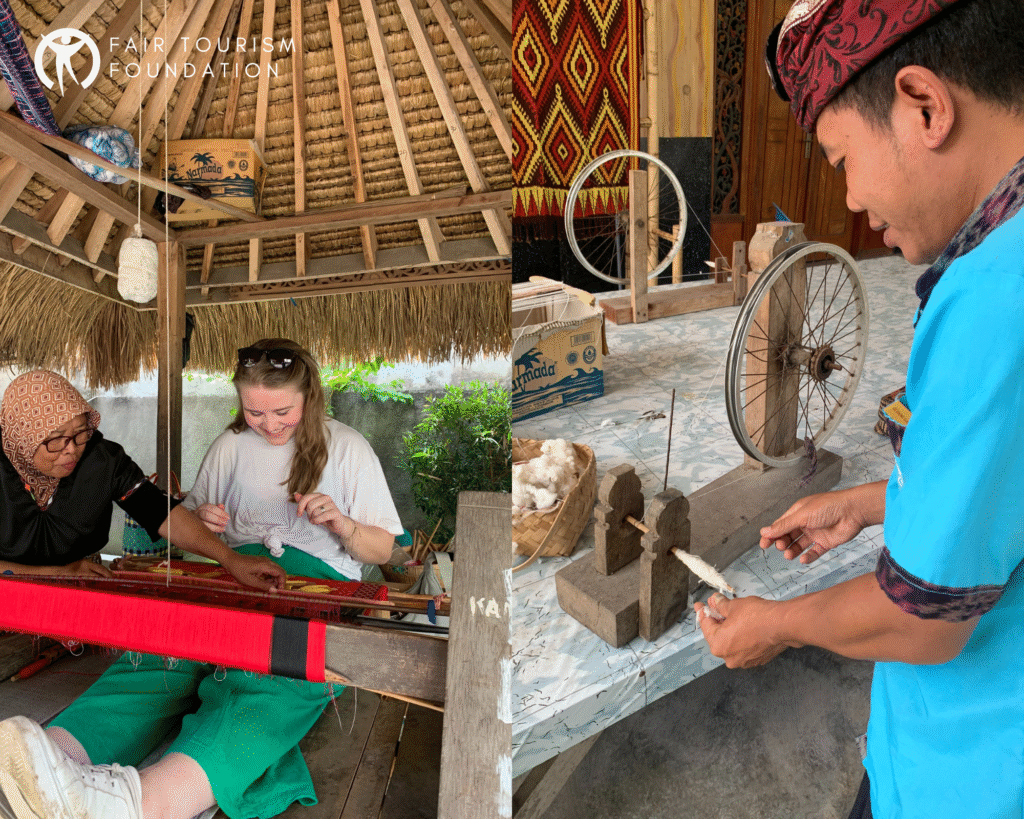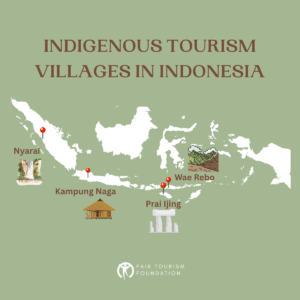Author: Iiris Hämäläinen

Let’s go on a journey. Not the one that leads straight to Indonesia’s tourism hotspot Bali, but a different route. One that goes through the islands of Sumatra, Java, Sumba and Flores, exploring the wisdom of Indigenous communities as they preserve their culture and nature.
Since the 1970s, Indonesia has been developing community-based tourism to alleviate poverty and preserve cultural heritage. The Indigenous tourism villages we are about to explore are models of regenerative tourism, where locals lead the way in protecting their heritage and passing on their ancestral knowledge.
What is regenerative tourism?
Before we go, it’s important to understand what is regenerative tourism. The main goal of this practice is for the visitors to have a positive impact on the destination, meaning they leave it better than they found it. The concept goes beyond sustainable tourism, which focuses on minimizing harm, to actively revitalizing places.
To see how regenerative tourism looks like in action in Indonesia, we begin our journey in the western part of Sumatra.
Nyarai Tourism Village, Sumatra
Hidden in the protected foothills of Bukit Barisan mountains, Nyarai Tourism Village in West Sumatra is not only known for its natural wonders such as Nyarai Waterfall and Gamaran forest, but its successful approach to regenerative tourism.
Here visitors are offered way more than just sightseeing and adventure. From fishing Mahseer in the rivers to trekking through tropical forest trails, all activities invite participants to connect with nature and create a greater understanding of environmental preservation. Tourists can also enounter with the local heritage by learning the martial art of silek, attend the vibrant event of Alek Nagari or engage in pasambahan speech tradition.
There is a strong belief in Nyarai that every part of the tourism system is connected: each action affects the wellbeing of the environment and society. This awareness is turned into reality through policies like maintaining forest paths and closing the tourist area every Friday to give nature time to breathe. Stepping into this village means stepping into an immersive and inspirational encounter that can renew one’s view on nature, tradition and the balance sustaining them. With this experience in mind, we journey towards the island of Java.
Kampung Naga, Java
Along the Ciwulan River in West Java, stands Kampung Naga, or also called the “Dragon Village”, where tradition shapes the life of a small community. With its thatched-roof bamboo houses built according to Indigenous beliefs, the village offers an example of cultural preservation in harmony with nature. The community’s zoning system, inherited from ancestors, divides the land into sacred, productive and residential areas. This ensures that the existing tourism gives priority to culture and customs. Forests designated as sacred are closed from tourists, protecting the environment and its services such as clean water supply and climate regulation.
The community of Kampung Naga has responded to global change and modernisation with wisdom. They participate in tourism training and offer guided visits and homestays without compromising their values and traditions. The tourism activities are carried out entirely through community labour, but they haven’t replaced the traditional professions such as farmers or artisans. Tourism in Kampung Naga is practiced as a community effort, where decisions and participation are guided by ancestral knowledge. As we leave the bamboo homes and sacred forests behind, our path carries us eastwards to the island of Sumba.
Prai Ijing Traditional Village, Sumba
Surrounded by lush green rice fields, the road climbs uphill toward Prai Ijing Traditional Village in West Sumba. Here the towering wooden houses with reed-roofs reach up to 30 meters high, surrounded by megalithic tombs.
This village is a hamlet of Tebara village, that unlike its neighbouring hamlets has successfully preserved its traditional way of life. Since officially opening to tourism in 2018, Prai Ijing has become a model for community-based tourism. The Tourism Awareness Group, Pokdarwis acts as a driving force in involving community members in managing and developing village tourism.
From the architecture of traditional houses to spiritual death ceremonies, the culture in Prai Ijing lives through everyday practices in which visitors can take part in. Women perform Woleka dances and weave palm leaves and vibrant fabrics, while men work as farmers in the fields or test their strength in spirited battles. Tradition is tasted in dishes like Kadodoka Modani and Rowe Kariwa and heard in the languages of Loli and Lamboya. In this remote village, tourism and tradition exist in harmony, each enriching the other. The journey leads us now even higher, to the mountains of Flores Island.
Wae Rebo Tourism Village, Flores
High in the mountains of Flores Island, wrapped in the dense forest of Todo lies Wae Rebo – a small village surrounded by rich vegetation, sounds of endemic birds and a relatively cool mountain air. Before entering the village, visitors are invited to take part in Pa’u Wae Lu’u ritual led by the village’s traditional elders to seek blessing from ancestral spirits.
Having got the permission and protection for their stay, visitors find themselves surrounded by tall, cone-shaped houses covered all over in lontar thatch. Each of these houses, known as Mbaru Niang, have five levels dedicated to specific purposes from daily living and food storage to sacred offerings to the ancestors. Around the village, locals plant coffee, vanilla and cinnamon to be sold in the markets.
The village is an example of tradition sustained through community spirit. Wae Rebo has existed in its current location since around 1920, but the community’s ancestral lineage stretches back nineteen generations. The village flourishes as a fully community-managed ecotourism destination, guided by the motto Mohe Wae Rebo, “Keep Wae Rebo alive.” From planning and development to decision-making and benefit-sharing, the locals lead every aspect of tourism.
Choose regenerative tourism
As seen throughout this journey, choosing regenerative tourism destinations means being part of a more meaningful exchange. These Indigenous villages invite visitors not only to witness culture but to respect and learn from it, helping sustain communities, traditions, and ecosystems that have lived on for generations.
So, as you plan your next journey, whether through Indonesia’s rich landscapes or beyond, choose destinations that allow for connection and growth. Your travel choices have the power to protect what makes these places special, not only for people now but for generations to come.
Here are a few tips for responsible travel in Indonesia:
- Choose Indigenous or Community-Based tourism villages
Opt for destinations where tourism is managed and led completely by locals. Among Nyarai, Kampung Naga, Prai Ijing, or Wae Rebo, there are plenty of different options around the archipelago you can choose from. Fair Tourism is also currently supporting a community-based tourism project in Mandalika, Lombok.
- Participate
Engage respectfully with the locals, so that it becomes a shared experience rather than a show or a performance. Always ask before taking pictures.
- Eat and shop locally.
Support local economies by eating regional dishes and buying souvenirs from local artisans or producers. This helps sustain traditional skills and keeps income within the local community.
- Learn before you go
Try to gain insights into your destination and the community you are visiting before you travel. Understanding the cultural etiquette, history, and traditions will help you to engage with the locals respectfully and meaningfully.
- Stay on the right track
Stick to marked trails to minimize your impact on the environment. Follow your guide and avoid disturbing wildlife.
- Travel slowly
Take your time. Fewer destinations mean deeper connections and experiences. This allows for more meaningful encounters and reduces environmental impact.


This Post Has 0 Comments